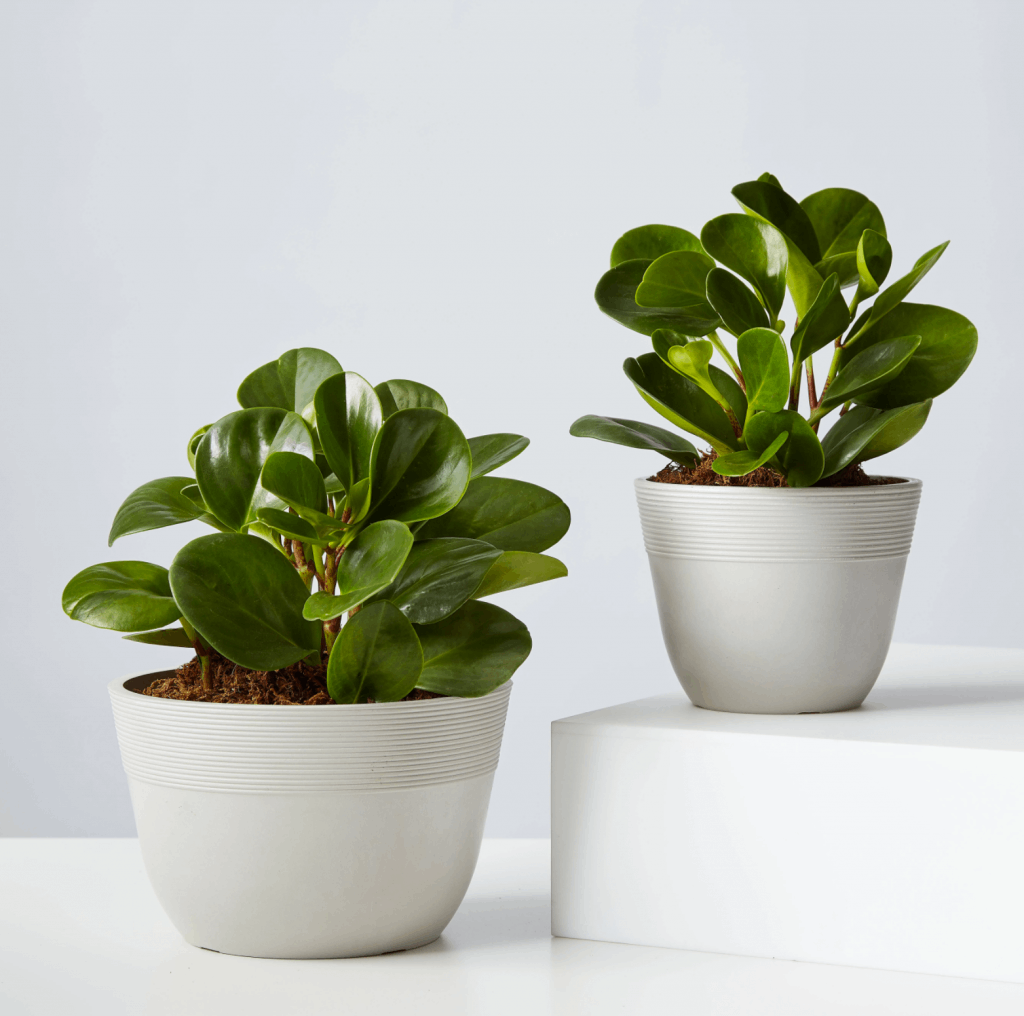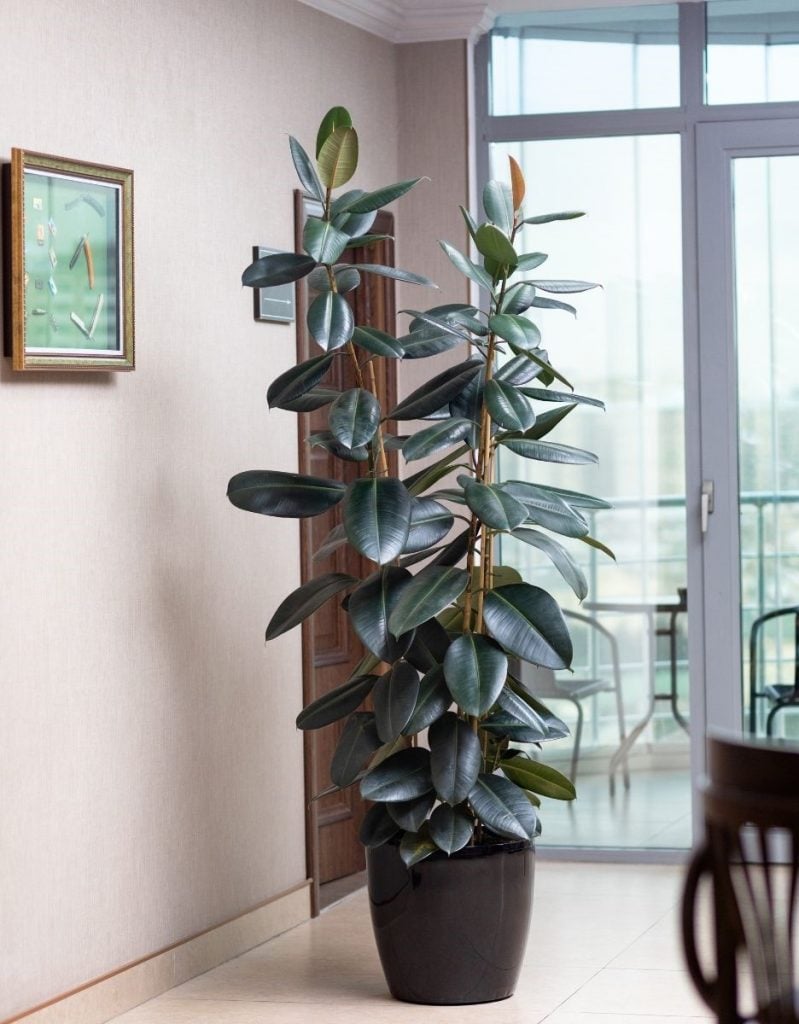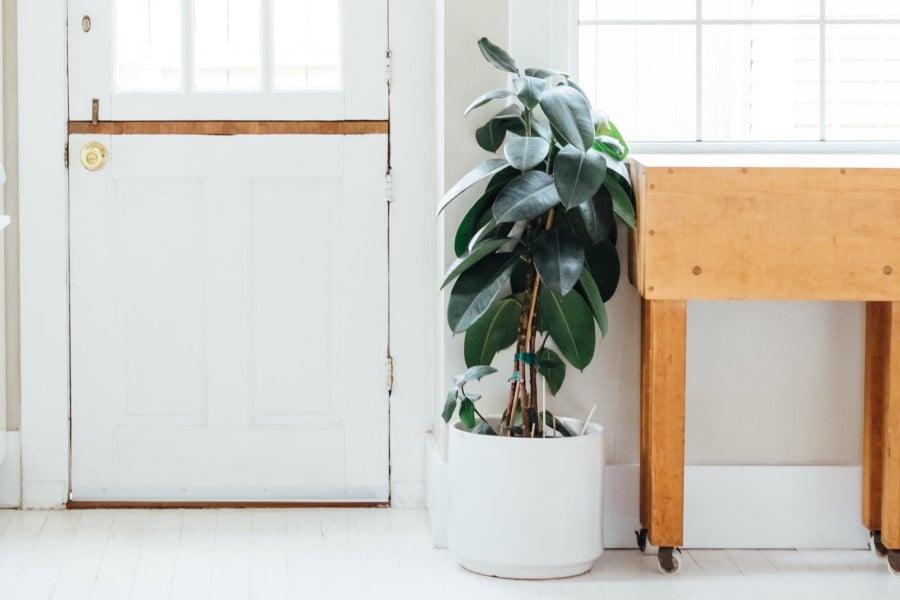Ficus rubber plants can make for the perfect trendy addition to your space. If you want to make your decor pop, add a stylish rubber plant to your home.
The trouble is, it’s not always easy to keep them healthy. They need the right amount of water, light, and humidity in order to thrive.
If you want decor stardom, but you’re unsure about your gardening skills, it’s time you learn how to care for this gorgeous species with these 8 tips.
Rubber Plants (Ficus elastica) at a glance

Rubber Plants are ideal houseplants for the indoor gardener. They thrive on neglect (no, really!), are decently maintenance-free, and can add a tropical feel to any room in your home. Given all of that, it’s no wonder they’re so popular!
With so many varieties available today, there’s something to suit every budget and taste. You can find them at most garden centres around the beginning of fall; they are a popular houseplant for Thanksgiving!
The rubber plant is a medium-sized indoor plant that belongs to the ficus plant family and are native to southeast Asia.
They are perfect for decor as they can be pruned into many shapes and sizes to fit nearly any spot in your home. They have gorgeous green and burgundy leaves and
They grow in USDA plant hardiness zones 8b through 11, so they can be grown both indoors and out. However, they won’t tolerate freezing temperatures so be sure to move them inside before the first frost.
The rubber tree has a long history of being used to make rubber products like latex for condoms, bandages, and medical supplies. In fact, the term “rubber” is where this common name comes from!
The best rubber tree varieties for indoors
Sumo
The best-known indoor rubber tree is probably the ‘Sumo.’ It has thick, glossy mahogany-colored leaves reaching 8 to 12 inches in length. The leaves are crinkled with rough edges and a prominent dimple on either side of the base.

Dwarf ‘mini’
Rubber Plants also come in smaller varieties like the dwarf ‘Mini.’ It has a vase-shaped form reaching only 12 to 16 inches tall and is ideal for a hanging basket because of its compact nature, but still boasting full size leaves.

Imperialis
Another smaller variety is the Neanthebella minima. It is also known as the “imperialis” type because of its thick, glossy leaves and strong upright posture. Like the ‘Mini’ variety, it is small enough to fit in a hanging basket giving it a more tropical feel. It can grow up to 1 foot tall with leaves reaching 3 to 4 inches long.

Petite Golden

The most compact rubber plant yet is the “Petite Golden,” reaching only 8 to 12 inches in height. As the name implies, this variety has a bright yellowish-green color to the leaves that are similar to the Sumo rubber plant. The key differentiating factor between it and ‘Sumo’ is its long, slender leaves that taper toward their tips.
Rubber plants have even been known to thrive with neglect! They can be placed in most indoor situations and will still manage to come out on top. However, some plant care tips are still recommended for this easy-to-care-for houseplant to ensure you get the best results possible.
How to care for a rubber plant
1. Bright, indirect light

Rubber plants should be placed in a room with bright, but indirect sunlight, and do best when they receive at least 90% shade throughout the day.
To achieve this for your rubber plant, a good option is to place it near an east or west-facing window so direct sunlight can shine through during the early part of the day while protecting it from the heat of the afternoon sun. To get the right balance of bright indirect light, you can simply push your rubber plant against a wall, or behind furniture to create the shade it needs.
Rubber plant light tip
A handy tip for excellent rubber plant care is to cover them with a shade cloth. This quick-fix works well for indoor growing. Try placing aluminum foil on sunny windows overlooking your rubber plant to block 90% of the sunlight from entering and harming the leaves.
2. The right amount of water
The rubber plant is a tropical plant that requires moist soil conditions to thrive. Because of this, many people are under the impression that they should keep the plant constantly wet. This isn’t true though — in fact giving your rubber plant too much water can lead to root rot and other problems. To avoid over-watering, make sure the soil is moist, but not dripping wet before giving it a light water.
Rubber plant watering tip
Place a clear plastic bag over the top of the rubber plant’s container and bring it down until there is about 2 inches of space between the bag and the bottom of the pot. This will allow the rubber plant to breathe while the bag retains moisture from escaping upwards, much like a greenhouse.
After you have placed the clear plastic over the container, wait a couple of hours to see if any condensation begins to form on it. If there is no moisture present, then this means that your rubber plant is ready for more water.

3. A loose soil mix is a happy soil mix
The first step in caring for your rubber tree plant is preparing the right soil, one that drains well and retains moisture but still provides plenty of air circulation. A mixture of 50% organic compost (like peat moss or leaf mold), 30% coarse sand, 10% perlite and 20% horticultural grit will result in good drainage and lots of room for water to reach the roots.
If you prefer to use inorganic soil mixes, combine equal all parts sterilized (sterile potting) soil made from pine bark with perlite.

4. Drainage holes to get the right water levels
The pots which you choose for these plants should have a hole in the bottom (or holes drilled into them). This is vital when caring for rubber trees outdoors so excess water can drain freely out of the pot instead of collecting and rotting at their roots.
For indoor plants, drainage holes are less important because you have more control over how much water your rubber tree gets.

5. Composting
Compost is very important when caring for rubber plants indoors because it helps to retain soil quality. In order to avoid the soggy conditions that are harmful to the plant, make sure your compost is well-draining. A good way to tell if compost is well-draining is by smelling it: If there’s no smell at all from the compost, then it’s perfect for your rubber plant care needs.

6. Fertilizer (during the growing season)
During the faster-growing times of the year, you can use a balanced fertilizer every two weeks or so. A balanced fertilizer contains nutrients such as nitrogen (N), phosphorus (P) and potassium (K). Some sources also list manganese (Mn), zinc (Zn) and iron (Fe).
During the slow season (such as winter) when it’s growing more slowly, a once-a-month dose should do just fine. Never feed your rubber tree plant if the soil is soaking wet from water; always allow a bit of time for drying first.

Plant fertilizer tip
If you have pets or small children in the house, keep the pot high enough that they can’t reach it! Keep your plants away from small children and animals as they could cause damage to them.
6. Careful pruning
The Rubber Plant is a plant that thrives on pruning. In fact, you should be doing an occasional light pruning of your plant in order to keep it healthy and revitalized. Out of control rubber plants can grow up to 50 feet tall in their native habitat.
This means making sure that the oldest leaves are cut off; these tend to fall off naturally over time anyway. If they do not, you can help them along by carefully cutting them off with sharp scissors or a knife. This will encourage new growth, providing more foliage for your home, and making it look even healthier than before!

7. Natural pesticides
Rubber plants can attract a wide variety of bugs and pests such as thrips and spider mites that are a pest to remove. The sap of the rubber tree will kill any insect that comes in contact with it, however, which makes your indoor palm tree care a little easier.
When repotting or re-potting, spray new soil from top to bottom (don’t spray directly on the plant). This will help prevent transferring insects into the pot. Always wash cutting tools between plants.
You may not see spider mites on your rubber plant, but they can be there! They tend to move around a lot and you can easily transfer them from plant to plant.

8. Temperature and humidity
Like most ficus plants, getting the right temperature and humidity in your home is important for your rubber plant to grow healthy, especially during a hot dry summer. For proper rubber plant care, they need warm temperatures between 60 degrees and 75 degrees with medium to high humidity, so don’t leave them near an air-conditioner!

Humidity tip
To give your rubber plant daily maintenance to increase the humidity and keep your plant looking fresh, especially in summer, there are two things you can do. First, use a spray bottle to mist the air around your plant. Secondly, you can use a damp cloth to provide some moisture direct to the leaves and wipe off any dust that has collected.
9. The proper pot size
The next most important thing is picking out the right sized container for growing rubber trees indoors. Generally speaking, it’s going to be much easier to care for one when it’s given plenty of room in its own “home.” Rubber plants don’t require vast amounts of space or sunlight (though they love both), but if you put one into too small a pot its root growth could become restricted.
When selecting a pot for your rubber tree, you should aim to give it at least three gallons of space in which to grow and develop. For example, if you already have one that is planted in a two-gallon container with drainage holes in the bottom, then this is an ideal opportunity to transplant it into something larger.

10. Look for a sign your plant needs help
Ficus rubber plants are easy houseplants to grow. Though you do need to keep an eye on it. One sign that is easy to spot is if the leaves turn yellow. When the leaves turn yellow, this means either you are giving your plants too much water, the temperature is not optimum, or your plants are getting much bright light.
On the other hand, when lots of leaves drop, this means it needs more light and you should move your houseplant closer to a window to get more natural light.
This concludes our guide to the Ficus Elastica rubber plant. We hope you found it useful. If you’re still looking for plant care guides, check out our article on the best plants and the best gardening tips too!
But, if you’re ready to start planting, it’s time to pick out that perfect planter.
